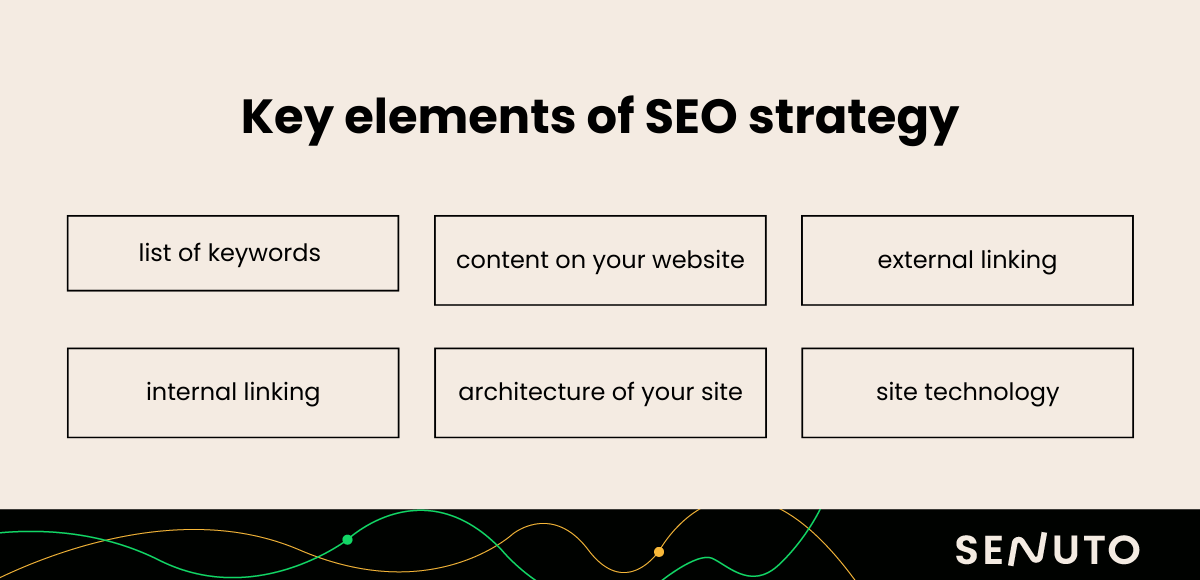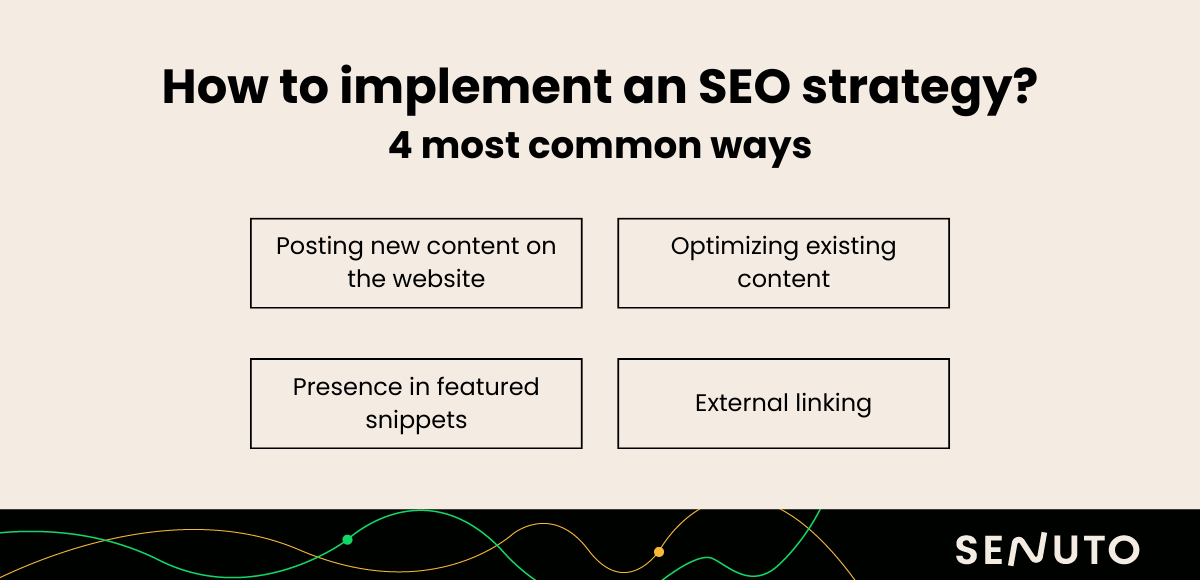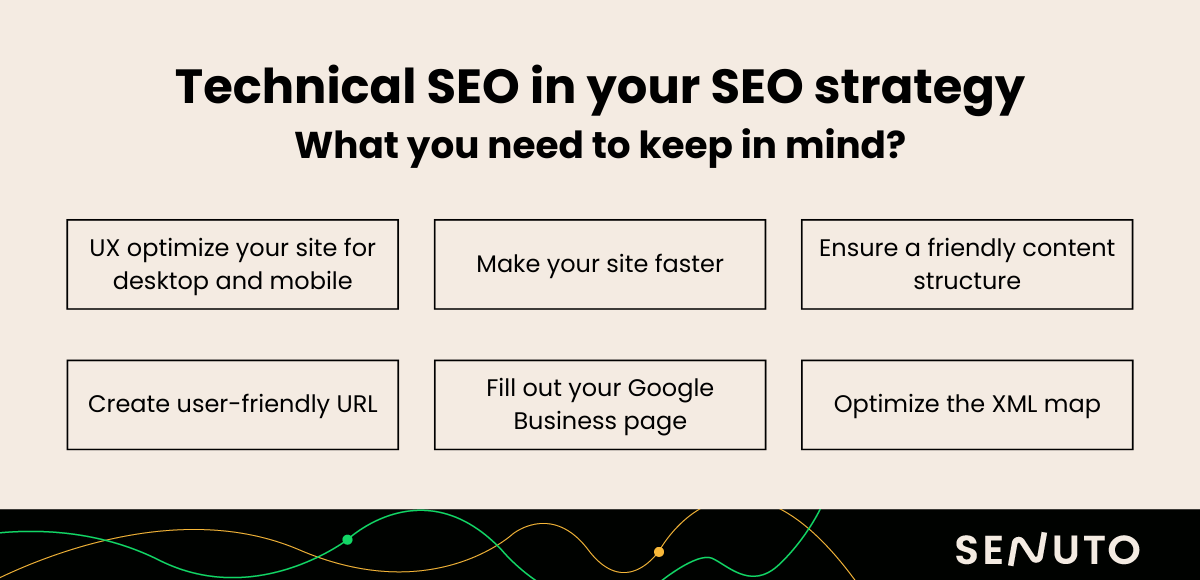These days, you can’t run a successful business on the Internet ignoring online marketing. SEO and SEM efforts generate traffic to websites, effectively attracting clients to content posted there. However, to unlock its full potential, you need a thought-through strategy. But what does an SEO strategy involve? How to prepare and implement it to eventually reach more clients?
What’s an SEO strategy?
An SEO strategy consists of a series of correlated activities on and around a website aimed at getting that website ranked for as many keywords as possible in organic search results. Briefly speaking, it’s about generating meaningful traffic to the website. Usually, it’s the priority of SEO efforts that can be expressed in secondary objectives. A quarterly SEO strategy may be focused on, for instance, increasing the visibility of individual sections of a website or improving a company blog.
A goal of an SEO strategy can be achieved only through coordinated and interrelated activities. Sounds seriously, doesn’t it? Don’t worry, we’ll elaborate on it later.

However, you need to be aware that SEO strategy, or more specifically the implementation of SEO strategy objectives and the achievement of specific results, takes time. These are long-term activities, planned for a long time from the very beginning. You may even have to wait several months for results. Indeed, the preparation of the strategy itself, based, for example, on market research and competitor analysis, takes quite a long time. Let alone harvesting.
How to SEO strategize depending on a business?
Once you’ve learned how much SEO can do for your business, only then you’ll be able to identify your needs and goals. As I already mentioned, SEO entails traffic generation; however, you actually don’t want every Google user to visit your website, but only those who are possibly interested in your products or services.
Perhaps your first actions won’t produce phenomenal results, but don’t be discouraged by this. As I said – SEO is ongoing activity.
Before taking the first decisions and specific steps towards SEO, your website should undergo a comprehensive SEO audit that outlines its strengths and weaknesses. This initial analysis will identify all aspects where your company’s growth potential lies. You will find a lot of important information about the condition of your website in the Visibility Analysis module, for example.
Why implementing an SEO Strategy is important?
Implementing an SEO strategy is crucial for several reasons.
Firstly, it increases the visibility of your website in search engine results, driving more organic traffic.
Secondly, this can lead to higher brand awareness and credibility, as users tend to trust websites that appear on the first page of search results.
Additionally, a well-executed SEO strategy can improve user experience by making your website more navigable and faster.
It also provides valuable insights into customer behavior through analytics, allowing for more informed business decisions.
Furthermore, effective SEO can result in a higher return on investment compared to traditional marketing methods, as it targets users who are actively searching for products or services related to your business. Lastly, staying ahead of competitors in search rankings can give your business a significant advantage in the market.
What constitutes an SEO strategy?
An SEO strategy consists of multiple elements which need to go hand in hand if you want the best results. Therefore, posting content regularly is not enough – in addition, you need to optimize it for Google, disseminate it on the Internet and build links, among other things.
Below are listed the core steps to take while devising a comprehensive SEO strategy:
- Analyse the current search engine visibility and attempt to maximise results.
- Identificate competitors and analysis of their SEO strategies.
- Create a list of keywords for which you want your website to get ranked on Google.
- Plan and improve content on your website following current trends on Google (learn more about topical authority)
- Create and post content on your website, for instance on your blog or in another site section
- Generate backlinks (external linking)
- Extend your internal linking profile – this often requires to revive and optimize old posts and articles
- Optimize the structure of your site – names of categories, tags, etc.
- Optimize your site technology-wise, for instance reduce page loading time and improve UX.
You will implement most of the above-mentioned elements of your SEO strategy using Senuto. For example, you can use Visibility Analysis to check the visibility of yourself and your competitors. With the Keyword Explorer, you complete your keyword research. The Content Planner will prepare a solid and data-driven content strategy for you, and the Writer will execute it thanks to the ability to generate AI texts. Then – to check that what you’re doing makes sense, you’ll see in Monitoring whether everything is working as it should.
Some strategies focus particularly on content, others are based primarily on technical and technological aspects of SEO. To tell the truth, every good strategy covers all of that; by combining these priorities, you can achieve the most. Let’s have a closer look at a few examples of an SEO strategy to see very diverse activities that can be taken to improve the visibility of a site on Google.

How to implement an SEO strategy? Examples and a few important rules
Below you can find some examples of what you can do SEO-wise. Just remember that your decision as to which activities to pursue should follow from specific business needs and goals as well as from SEO audit results. It’s a strategy that needs to be carefully thought-through and then implemented properly and without haste.
It’s crucial for you to realize that using similar solutions won’t make every website a great success. The final outcome of SEO efforts depends on, among other things, a type of your business, an industry in which you operate and what your competition does on Google.
An SEO strategy can be executed by a specialist, but you can also do a couple of things by yourself. You may learn more about it in the article by Damian Sałkowski titled “SEO – what to optimize in-house and what to outsource?”

Example no. 1 – Posting content on the website
Using keyword searching tools (Senuto Keyword Explorer), an SEO expert finds out what people want to read and plans content accordingly.
Articles posted on your website ought to be of high quality – they should fully cover the topic and be free from language errors. If they’re broadly promoted and get ranked high in SERPs thanks to additional SEO efforts, they’ll reach a lot of users.
If your audience likes them, they’ll also generate a high number of backlinks and will be disseminated across social media.
Senuto helps in this process. In Senuto, you can do keyword research in the Keyword Explorer module. You can also rely on your competitors’ visibility and, in VA, extract phrases for which your competitors are visible and you are not. Content, on the other hand, can be successfully written or generated in Writer
Read also: SEO Copywriting – 5 Rules You Should Stick To
Example no. 2 – Optimizing content
Another step to take as part of an SEO strategy involves the optimization of content already posted on your website. It’s very useful when it comes to old and big sites.
When obsolete content is brought up to date, improved and search engine optimized, it gets a new life and becomes more search engine friendly. While you’re at it, make some tweaks to the internal linking system and Onsite SEO.
How to do it? Start a project in Writer for the most important word of the article, then paste in your existing text. Check what words you’ve used, what words you’re missing, make changes and enjoy up-to-date content and new visitors.
Example no. 3 – Presence in featured snippets
Yet another strategy involves getting some presence in featured snippets. Google displays featured snippets at the very top of SERPs, in so-called position zero. They’re supposed to quickly and unambiguously answer a query of a user.
How to get into featured snippets? There’re numerous methods of doing that, depending on types of snippets displayed for a given keyword. Examples of snippets include lists, explanations, step-by-step tips, quick answers to simple questions and results on Google maps. To get displayed in snippets, you need to create content tailored to the form of a particular snippet. Therefore, if you dream of being displayed above the first position in SERPs for a keyword that triggers a list at the top of results, the first thing you should do is add a similar list in your article.
Example no. 4 – External linking
Another strategy entails sourcing backlinks from websites respected in a given industry. Not only do such backlinks generate traffic themselves, they’re also one of the most essential ranking aspects taken into account by Google.
Establishing backlinks to a website is one of the most difficult steps of SEO strategy implementation. The more sites considered valuable by Google backlinks to your website, the more trustworthy Google finds your content. Besides, backlinking websites will simultaneously generate some traffic to your site.
How to devise an SEO strategy step by step
Notwithstanding whether you outsource it to an SEO specialist or try to do it on your own, it’s always good to know how this process unfolds. Have a look at an example below.
These are typical steps to take while planning SEO efforts for any site, regardless of its type and form. With this guide you’ll learn where to start if you decide to dive into website positioning by yourself. Once you know more about it, tailor your strategy to individual needs of your site.
Kick it off with keywords
Check which phrases your website is already visible in Google for
Check which phrases your website is already visible on Google It is useful for you to know what your starting position is. You can check all the phrases for which your website is already visible in Google in Senuto.
Take a look at your competitors
In the same way as you analyse your own site, you can also analyse the Google situation of your competitors’ domains. Instructions on how to see which phrases your competitors are visible on Google and you are not can be found here.
Find keywords that your possible clients type in the search engine. Keyword selection is one of the first steps of an SEO campaign. When you know your keywords, you’re able to determine which of them are the most important to you so you can focus specifically on them.
You can find keywords associated with your products and services in Senuto Keyword Explorer. Use long-tail keywords consisting of multiple words – there’s less competition for them when compared to typical one- or two-word key phrases.
Don’t forget to repeat the keyword identification process regularly from time to time.
Make use of keywords while planning and creating content
Types of content
Relying on identified keywords, you need to plan content to be posted at your website. Choose a place for that as soon as possible and begin creating content on a regular basis. When planning content, it’s worth trusting data instead of intuition. It’s a more dependable path to success.
There’re two types of content worth creating and posting:
● Evergreen articles are content searched for on Google regularly because topics discussed there are relevant. Find out which questions related to your industry are asked on Google and answer them with your content. Some examples:
Guest blogging – Why You Should Post Articles on Your Partner’s Website?
Site Migration – How to Do It Right?
● Articles discussing current topics which are gaining relevance and are often commented by people in the industry. Taking part in a lively discussion can get you far – in terms of not only traffic but also business partners, respect and brand recognition. An example might be articles about Google algorithm updates posted on our blog:
Algorithm Update of March 12 – Medic Update?
Build semantic context around your principal keyword
Build semantic context for your content! Google analyzes whether content posted reads smoothly and includes thematically-related keywords.
If you don’t know which keywords you should put into your text to create semantic context, log in to Senuto and go to Related Keywords.
Keywords in content
There’re a few features that should characterize all of your articles if you want to get ranked high in SERPs. First of all, Google prefers longer articles, though that doesn’t mean you should waffle. A good article is both extensive and informative.
Every article you post ought to revolve around a specific keyword. However, don’t put too many keywords in an article so that it doesn’t look unnatural. Overusing keywords might prove counterproductive. It also needs to be pointed out that Google knows what inflection and synonyms are so you don’t have to worry about whether to choose “vehicle” or “car”. Text needs to flow naturally, there shouldn’t be any fragments that seem to be artificially adapted to a particular additional keyword.
Keywords ought to be included in:
- the title,
- the lead (first paragraph below the title),
- a few headings, preferably at the very beginning,
- page metadata (meta title and meta description),
- descriptions of images.
Writing optimised content will be simpler and, above all, much faster if you use the support of Senuto’s Content Writer to do so. It is not only a content editor, but also an AI content generator. With a robust analysis of the first 20 search results and AI supercharging, you get keyword recommendations and text structure. You can also choose to generate text with the help of AI. In the same way, you will create meta data for specific texts.
And all this in a matter of minutes at the most.
Post images and videos
Both Google and users prefer content with images and videos. Including such materials in an article makes them all happy, and this considerably affects your rank in SERPs.
Instead of using stock photos, create your own eye-catching infographics. However, as I’ve mentioned earlier, they need to be optimized in terms of size and page loading speed.
Internal linking extension
By creating a vast system of internal links you inform Google that your site is a well-organized library of intertwined content and not some pile of unrelated data roaming free. Find articles covering similar topics and, when possible, add relevant URLs to them so that they direct to each other. It’s also a good idea to set up a ‘Read also’ section where you’ll recommend other similar pieces of content to your audience.
Tip: Connect pages that generate huge traffic to your website with pages that convert greatly – it’s a wonderful way to increase your profits.
Acquisition of backlinks
The best way to persuade other sites into backlinking to your website is to post high-quality content. Join discussions about relevant topics, share knowledge, draft reports – if they’re worth recommending, people will direct users to them.
Sometimes it’s also possible to write a guest post on popular blogs which will give a precious backlink in return. You can also buy sponsored articles from an agency. Check this possibility out in Linkhouse or Whitepress.
You should never spam links to your site on forums or buy links from link farms. Google may spot such practices and penalize a site for that, decreasing its rank on Google.
Keywords are not everything – technical SEO
While implementing an SEO strategy, do the following:

UX optimize your site for desktop and mobile
Both desktop version and mobile version of your website need to be user-friendly. For some time now, Google follows the mobile-first approach. This means that sites need to load quickly on mobile devices and their interface has to be tailored to the needs of smartphone and tablet users.
When mobile optimizing a site, don’t ignore desktop user experience! Google takes that into consideration as well.
Make your site faster
Page loading speed considerably affects your site ranking. Do everything you can to make it load faster. First, reduce the size of images posted on the website and shorten its code if possible. When you don’t know how to do it, ask your web developer.
Ensure a friendly content structure
A friendly structure of content posted on a site means an easy-to-navigate menu and category dropdown on one hand, and a place where it’s good to include keywords searched for most frequently in respect of your business on the other. Develop your content structure based on data from Senuto Keyword Explorer and Content Planner. This way you’ll make it easier for Google to understand what your site is about. You’ll feel the difference in the visibility of your website in SERPs.
Revive old posts
A site with a sufficient amount of content gets a substantial amount of organic traffic from posts and articles posted over a month ago. That’s why it’s worth reviving old posts from time to time to make them more up-to-date and useful to users. Like I’ve said before, it’s also a good idea to develop your internal linking system, which will help to connect customer journey steps and present the user with both hot news and older posts.
Create user-friendly URLs
It’s crucial to make links directing to your site user-friendly. In other words, they should contain words and not series of digits. They need to clearly suggest to what they lead. Including a keyword for which you want to get ranked in a URL can work wonders as well, but don’t make it too long!
Let users leave a comment
Ask your audience for feedback! And do it not only when you run an online store or a restaurant. For a majority of businesses, it’s a good practice to allow users to leave a comment about products or services they bought from you. This makes you more trustworthy, and additional, user-generated content affects site ranking on Google.
Fill out your Google Business page
Every business with a physical place open to customers and clients (hairdresser’s, pizzeria, tailor shop, etc.) should have its own Google Business page – this makes it possible to spot your business on Google Maps. Numerous local businesses generate most of its website traffic through Google Maps.
Take some time to optimize the XML map
Make sure that the XML map of your site is well-designed. This will help remove those pages from Google index which are strictly of technical value and shouldn’t be reached by users from the search engine directly. Examples include a password recovery page, navigation pages or user account pages.
Beware content cannibalization
Content cannibalization is something you definitely want to avoid. Content gets cannibalized when more than one page of a site are optimized for the same keyword, which results in site rank rotation and in decreasing its visibility on Google.
To protect your site from duplicate content, make sure that every page and blog post has unique titles and is optimized for different keywords. Content cannibalization is particularly characteristic of online stores and follows from overusing the same or virtually indistinguishable descriptions of products offered.
SEO is all about the user
Content marketing as an answer to users’ needs
High quality of articles is one of the best SEO tools. Content posted at your site needs to be of unique value to users and solve their actual problems. Write posts and articles you’d like to read yourself. Your content must stand out and offer your audience something they cannot find anywhere else. Content marketing is an inseparable element of the SEO process. Posting plenty of well-planned and well-written articles is an essential part of every site ranking strategy. A lot of specialists achieve great results by creating whole campaigns revolving around content posting.
And while years of working in this area may have made you used to creating content yourself, remember that in the age of AI, this is much simpler. You can, for example, reach for the Senuto Writer and, with its help, generate texts for up to several months ahead in a matter of minutes. By the way, you can be sure that these texts will be perfectly optimised and created, among other things, to work on the visibility of your website.
Identify personas
To write eye-catching articles, it’s useful to establish personas depicting your typical client or customer. This will help you tailor content to their needs and expectations. When you imagine who your readers are and what their needs and expectations are, it’ll be much easier to create content that they seek. There’re multiple methods of collecting information about clients – you can ask them to fill out a post-purchase questionnaire or you can collect data on your own, digging through forums and other sites where they comment. You may also ask them a thing or two in a face-to-face meeting.
A great way to look at things from clients’ perspective is to take a peek at social media. It’s worth following what they write (not only on your profiles but also on profiles of your competitors). Their comments and reactions tell a lot about what they find interesting and in which topics they engage more eagerly. Don’t underestimate the impact of influencers popular among your audience! If you have some money to spend, you can invest in marketing research that’ll make it easier to identify personas.
Monitoring and analysis of results
A very important part of implementing an SEO strategy is the continuous, regular monitoring of the effects of SEO activities. Use available analytical tools for this, such as Google Analytics, Google Search Console or Senuto. Monitor site traffic, user origin, site behaviour, conversions and other metrics that will allow you to optimise your strategy.
Summary
Should you wish to invest in search engine marketing, devise a comprehensive SEO strategy together with an experienced SEO expert and follow it as closely as possible. If you have an agency to do that for you, carefully read reports they provide you with and talk to their experts about your needs.
It’s important that you understand what they’re doing for you and your site. Make sure their activities are effective and compliant with your general marketing strategy; this way SEO will become a never-ending source of traffic to your website with a high conversion rate.
 Karolina Matyska
Karolina Matyska  Iza Sykut
Iza Sykut